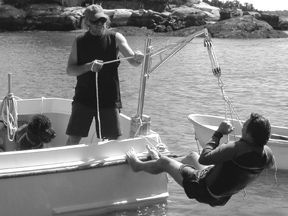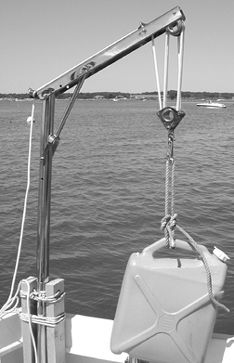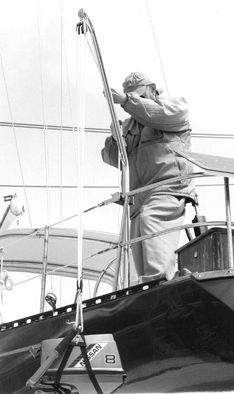
There was a time when you could unclamp the 70-lb. outboard from the transom of the inflatable, stand braced like Atlas in the cosmos, press the engine overhead, and settle it onto its mount on the rail. Those jerry jugs full of fuel and water, those bags of groceries, those duffels that the country cousins brought with them, full of hard-soled shoes and fancy French water and hair driers—all those things, back in the day, popped over the toerail and onto the deck with a blithe effort on your part.
There comes a time, however, when the joy of wrestling heavy pieces of gear on and off the boat begins to fade. Losing an engine overboard, or nearly losing it while barking your shins and knuckles, stubbing your toe, and ripping your shorts, makes you yearn for an easier way. And, of course, gear hoists (aka gear lifts, motor hoists, lifting davits) are the way.
Where We’ve Been
We haven’t visited the subject for some years. In 1997, in concert with our colleague publication, Powerboat Reports, we reviewed five hoists—from Forespar, Garhauer, St. Croix Marine, Atkins & Hoyle, and Marshall Design. Marshall Design at that time made the Nova Lift, which was distinguished from the others by the fact that it relies on a cockpit winch for hoisting power, rather than using a block-and-tackle arrangement at the end of its hoisting crane.
In testing the hoists with 100-pound weights, and then to the maximum rated weight for each hoist, we found that they all performed as specified, with only a few minor disturbances. We noted that all hoists were easy enough to set up, take down, and stow. None of this is too complicated.
At the end of the first round of tests we liked the Nova Lift for its clean, clever design, and its effective use of existing winch power. Best Buy, however, went to the Garhauer Lifting Davit, which worked like a charm for a lot less money than the competition.
The following year we covered the Kato Lift, from Kato Marine. Like the Nova Lift, it’s an attractive design made of a single piece of stainless steel tubing with appropriate bends. Unlike the Nova, it uses a block-and-tackle for hoisting. We liked it as much as the Nova Lift, and it cost less, so it was easy to recommend.
Where We Are
Though it’s now time to revisit lifts, in speaking with the manufacturers we found that very little has changed—not enough to test the whole field again. The update chart appearingon these pages recaps our findings, lists product details, notes any physical changes in the products, and gives the latest list prices.
There’s a newcomer, though: Island Marine Products, a Florida company whose outboard motor lock was featured here recently, now also makes a motor/gear lift. We asked if they’d like to send us a lift for evaluation, as a way to revisit this topic, and they kindly consented to do so. We also invited the owners of Garhauer Marine in California to loan us their Lifting Davit again, for comparison’s sake. As mentioned, it was the Best Buy last time around, and owner Bill Felgenhauer tells us the product is still selling briskly.
Observations
We mounted both hoists in a temporary brace of 2 x 4s and lashings, with their supplied bases. Instead of using the supplied rail-mounts, we simply side-braced the support poles at 30 inches, a standard height for stern pulpit rails.
We experimented with raising, lowering, and swinging various objects, including people and 48-pound jugs of water. There’s no big news here—both hoists did their essential jobs well, and with 6:1 purchases, little muscle power was needed, even to lift a 180-pounder out of the water.

]There is a difference in how the lines are controlled and belayed. The Island Marine hoist has a thin-horned cleat welded to the top of the crane section; with a heavy load to lower, the hoister can take a turn around the base of the cleat for better control. The Garhauer hoist has a cam cleat mounted on the back of the crane section, which controls the line on the hoist. When a load is lowered, the line must be kept clear of the cam cleat. Essentially, the Island Marine hoist offers better control on the way down, and the Garhauer better control on the way up. We developed no particular preference, since pretty much any load sensibly contemplated for these hoists can be held by hand.
The upright part of the Island Marine hoist measures 60″ in a single piece. The crane section has pintles top and bottom, with the top one longer, so that the unit can be lifted up and the pintles then settled down into gudgeons welded on the upright tube. It’s a simple and clever arrangement, and is almost exactly the same as that on the St. Croix Marine hoist (model 175, “Little Crane”), which has been on the market for years. The stainless work is heavy and top-quality.
The Garhauer hoist is also a stainless steel work of art. The upright portion is made of two sections, one of which sleeves into the other. Overall height is 62″. The 26″ crane section carries a diagonal brace that is bolted through the upright in either an upper or lower position.
While the Island Marine lift uses a detachable Harken block and tackle system, the Garhauer uses (of course) a Garhauer block system, with the stationary triple block integral in the front of the crane. Both hoists use carabiner-type lifting hooks below the moving triple blocks.
Styles
Gear lifts come in three basic forms, or design styles. First is the fold-down crane style, represented by the Forespar and Garhauer hoists. Second is the removable-crane style, represented by the St. Croix Marine, Island Marine, and Atkins & Hoyle lifts. Third is the one-piece bent-pipe style, represented by the Nova Lift and the Kato Lift. The Tops-in-Quality Hoist-A-Weigh models are a variation of this, but with permanently welded bracing systems.
Given the typical chores assigned to these lifts, we can see no overwhelming advantage to any of them. It seems to be more a matter of style, stowage convenience, and type and frequency of use. If we were lifting a 100-pound outboard on and off a dinghy transom several times a week, we’d probably leave the hoist rigged and ready anyway, whether we could detach the crane arm or not.
Aesthetics are important, and some of these hoists, if left rigged, will certainly look out of place on some boats. To our eye, the least obtrusive hoists are the Nova Lift, now marketed by Forespar Marine, and the Kato Lift. Both of these are simple bent-pipe designs that rely on the wall thickness of the stainless tube for strength. The original Nova Lift was designed to work with a cockpit winch for mechanical advantage, but Forespar’s Art Bandy tells us that the company now makes a version that integrates their Marelon® winch on the lower part of the upright. The entire package is Forespar part #153312; cost is $800.
The Kato Lift, rated for slightly more weight, is still more attractively priced than either Nova Lift version. We’d opt for a 4:1 or 6:1 tackle, rather than the supplied 3:1 version, which would bring the price in line with the original tackle-less Nova Lift.
Mounting Options
Although stern pulpit corners are the most common location, hoists can also be located on transom and boarding platforms, inside high cockpit coamings, and even, in some cases, on inclined surfaces. Your best plan of action would be to decide on a style that suits your boat and your hoisting habits, then figure out where to put it, and then, if the answer isn’t obvious, call the manufacturer for advice on how to mount it. Every hoist maker we spoke to said they were willing to advise customers on that score, and most make fittings to cover at least a small variety of situations, both for the base mounting and the upright tube support.

]The design of the upright tube on the Island Marine hoist is a good example of adaptability: It’s through-bolted slightly above its base bracket, so that the base bracket, in turn, can be bolted through a flat surface up to about 25° past horizontal. There’s also a transverse set of bolt holes so that the upright (with its welded gudgeons) can be turned 90° if necessary.
Conclusions
The new Island Marine lift that got us started on this update is an excellent piece of workmanship for a decent price. (So is the St. Croix Marine hoist that seems to have inspired it.) We’d be glad to own either one, but think of them more as permanently mounted hardware on bigger boats, or even on docks. (There’s a nice situation—a hoist on board the boat, and a matching hoist on your private deep-water dock, tended by a cadre of Olympic synchronized swimmers…but we digress.)
Among the single-piece, bent-pipe-style hoists, we still like the Kato Lift. It’s well-built, priced right, and enthusiastically supported by its makers in Annapolis. When we spoke with them, they were busy custom-making a set of extended davit supports for an owner who had clearance problems.
Again, there are always issues of stowage, looks, hoisting habits, and mounting options to consider, but when you weigh everything together, the Garhauer lift is still difficult to beat. It’s a superb design, excellently built, for a price that sets it well apart from the competition. PS reader Neil Walters of Dunedin, FL, wrote us a few months ago: “I purchased a Garhauer lifting davit. It is built like a fine precision watch, easy to install and remove each time I use it. They are also the cheapest priced davit on the market by far. The quality is unbeatable. With a lifting harness, it makes it a snap to lift the outboard to the dock or back to the boat.”
We think Neil has it right.
Also With This Article
“Value Guide: Gear Hoists”
































